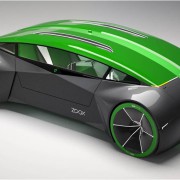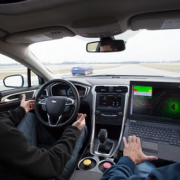Self-Driving Forklifts Automate Warehouses
Burney Simpson
Automated, electric-powered forklifts developed at the Carnegie Mellon Robotics Institute are contributing to the growing use of self-driving technology.
Coraopolis, Penn.-based Seegrid takes off-the-shelf electric-powered forklifts, adds hardware and software, and turns them into Vision Guided Vehicles (VGV), said Amanda Merrell, Seegrid marketing director.
Once transformed, the VGVs perform such warehouse tasks as Put Away; Long Haul; End of Line where the finished product is taken to a shipping dock; Replenishment where inventory is moved from storage to picking; and more.
Seegrid says its VGVs reduce labor costs, improve warehouse safety, and increase productivity.
Customers include Volvo, Daimler, Denso, BMW, Jaguar Land Rover, and Freightliner.
This YouTube video cleverly contrasts the measured style of the automated VGV with its human-operated counterparts - Seegrid Vision Guided Vehicles in Action.
The hardware that Seegrid adds includes 10 cameras that keep the forklift aware of its surroundings.
The software includes coding that allows the warehouse operator to program a driving route for the VGV.
“You simply get on the machine, hit record, drive it on some particular route, get off, hit play, and it just loops around on that route forever,” Seegrid CEO Jim Rock told radio station WESA fm in Pittsburgh.
It hasn’t all been easy. Seegrid declared Chapter 11 bankruptcy in 2014 as it got ahead of itself and explored new markets. Rock helped the firm to re-focus on its core forklift sector. In addition, supermarket operator Giant Eagle, an original Seegrid funder, agreed to swap debt for a greater equity share of the firm.
The company exited bankruptcy in February 2015.
A customer that purchases VGVs will use the Seegrid Supervisor app to manage the devices. It provides for real-time monitoring, intersection control, and the ability to set operating rules, such as recharging.
To do that, the VGV is programed to visit a charging station once its battery power has dropped to a certain level, “say when it’s at 30 percent,” said Merrell.
A human is still needed to physically attach the forklift to the recharging station, said Merrell.
Rock says the VGVs have operated safely for more than 125,000 miles due to sensors that ‘tell’ the machine when a human is within a certain distance. And the VGVs beep and make other noises as they move so workers are made aware of their presence.
Dr. Hans Moravec developed the Seegrid technology at Carnegie Mellon in Pittsburgh. The company was founded in 2003 and launched its first VGV in 2008.


